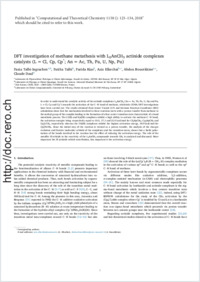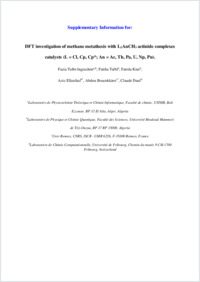DFT investigation of methane metathesis with L2AnCH3 actinide complexes catalysts (L = Cl, Cp, Cp*; An = Ac, Th, Pa, U, Np, Pu)
- Talbi-Ingrachen, Fazia Laboratoire de Physicochimie Théorique et Chimie Informatique, Faculté de chimie, Alger, Algeria - Laboratoire de Physique et Chimie Quantique, Faculté des Sciences, Université Mouloud Mammeri de Tizi-Ouzou, Algeria
- Talbi, Fatiha Laboratoire de Physique et Chimie Quantique, Faculté des Sciences, Université Mouloud Mammeri de Tizi-Ouzou, Algeria
- Kias, Farida Laboratoire de Physique et Chimie Quantique, Faculté des Sciences, Université Mouloud Mammeri de Tizi-Ouzou, Algeria
- Elkechai, Aziz Laboratoire de Physique et Chimie Quantique, Faculté des Sciences, Université Mouloud Mammeri de Tizi-Ouzou, Algeria
- Boucekkine, Abdou Univ Rennes, France
- Daul, Claude Département de Chimie, Université de Fribourg, Switzerland
-
15.08.2018
Published in:
- Computational and Theoretical Chemistry. - 2018, vol. 1138, p. 123–134
English
In order to understand the catalytic activity of the actinide complexes L2AnCH3 (An = Ac, Th, Pa, U, Np and Pu; L = Cl, Cp and Cp∗) towards the activation of the CH bond of methane, relativistic ZORA/DFT investigations have been carried out. The results obtained from Linear Transit (LT) and Intrinsic Reaction Coordinate (IRC) calculations show that the mechanism involved in these reactions starts with a proton transfer from methane to the methyl group of the complex leading to the formation of a four center transition state characteristic of a bond metathesis process. The U(III) and Np(III) complexes exhibit a high ability to activate the methane CH bond, the activation energies being respectively equal to 10.5, 17.1 and 21.0 kcal/mol for Cl2NpCH3, Cp2NpCH3 and Cp∗2UCH3 respectively whereas the Th(III) complexes exhibit the highest activation energy, 34.9 kcal/mol for Cp∗2ThCH3. Since the initial step of the reaction is viewed as a proton transfer, the analysis of the charges evolution and frontier molecular orbitals of the complexes and the transition states, shows that a facile polarization of the bonds involved in the reaction has the effect of reducing the activation energy. The role of the metallic 5f orbitals in the reactivity of the L2AnCH3 compounds towards CH4 is analyzed and discussed. More important the 5f actinide orbital contribution, less important is the activation energy.
- Faculty
- Faculté des sciences et de médecine
- Department
- Département de Chimie
- Language
-
- English
- Classification
- Chemistry
- License
-
License undefined
- Identifiers
-
- RERO DOC 323327
- DOI 10.1016/j.comptc.2018.06.009
- Persistent URL
- https://folia.unifr.ch/unifr/documents/307259
Other files
Statistics
Document views: 80
File downloads:
- pdf: 244
- Supplementary material: 121

